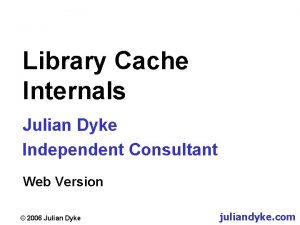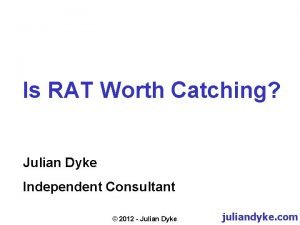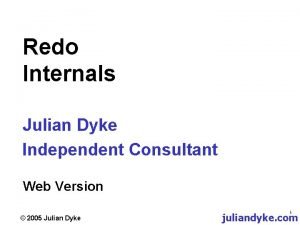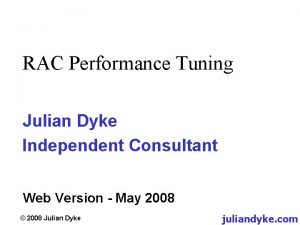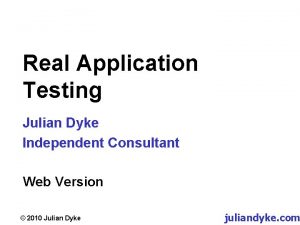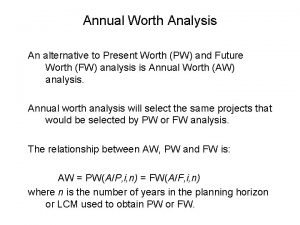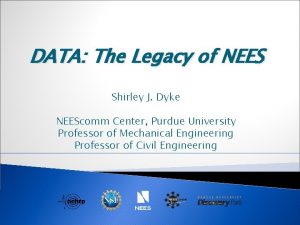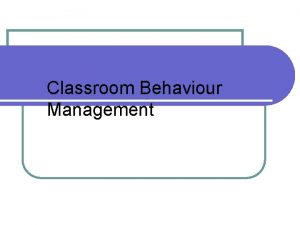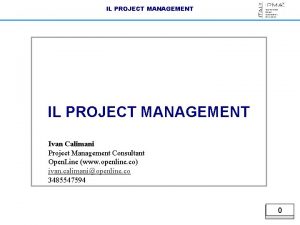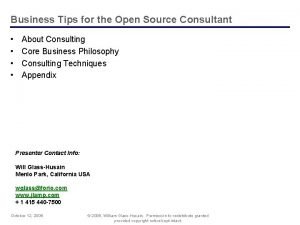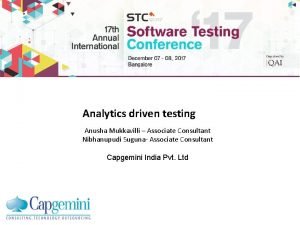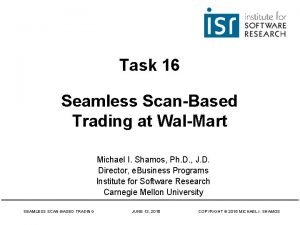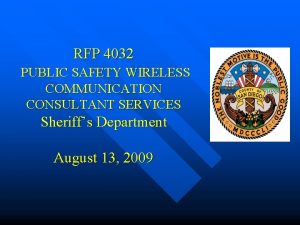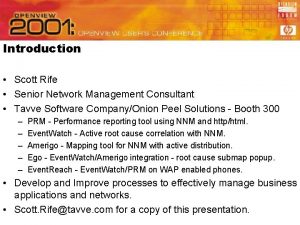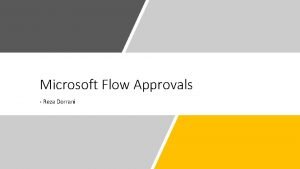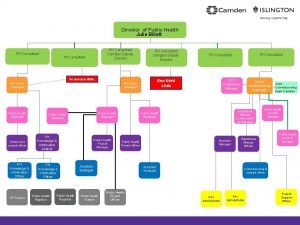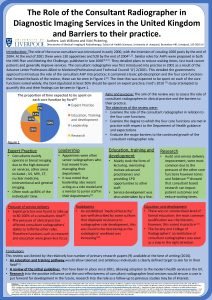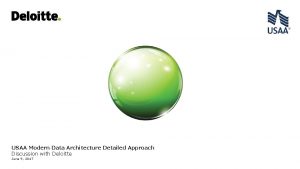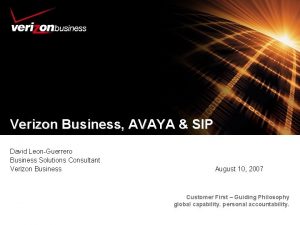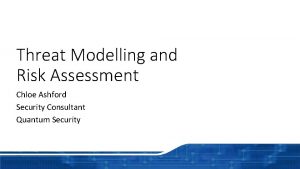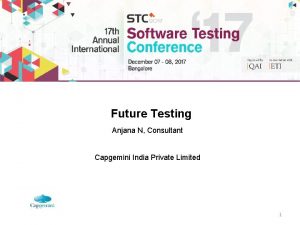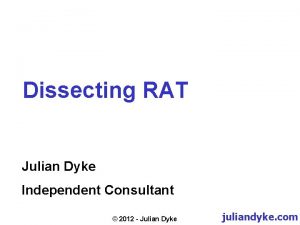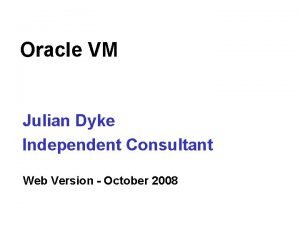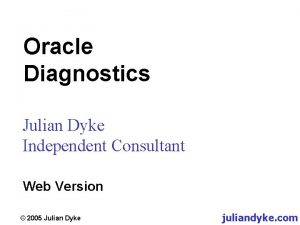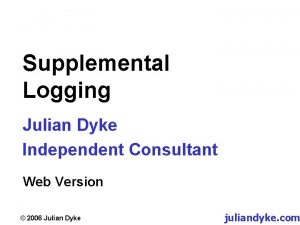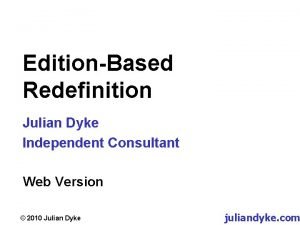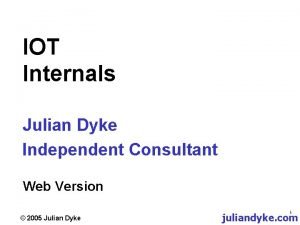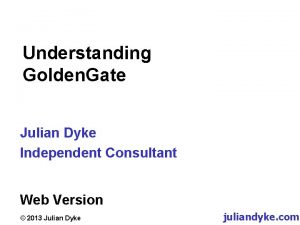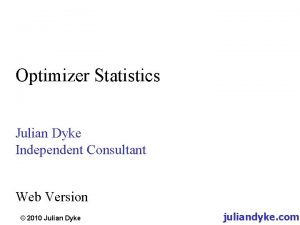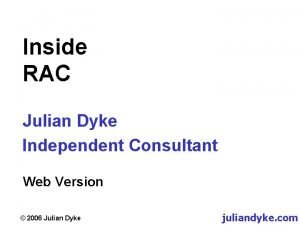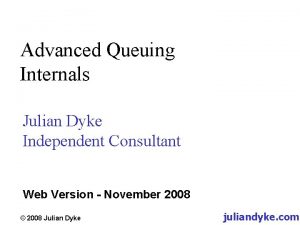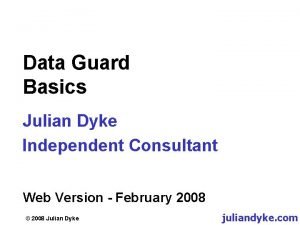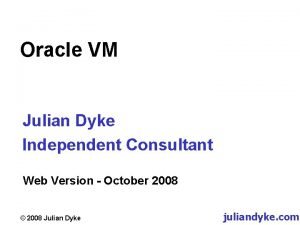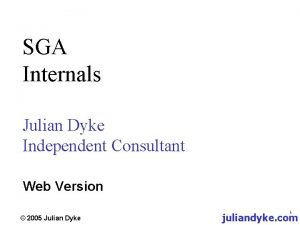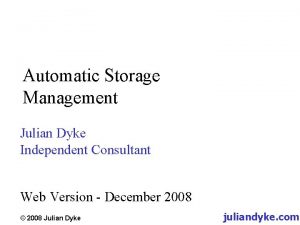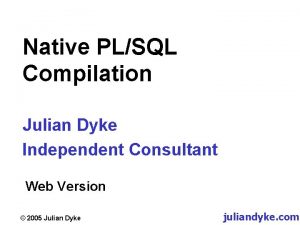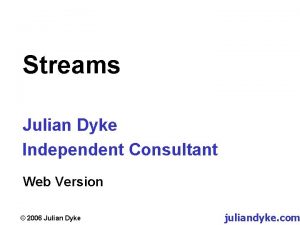Is RAT Worth Catching Julian Dyke Independent Consultant


































































- Slides: 66

Is RAT Worth Catching? Julian Dyke Independent Consultant © 2012 - Julian Dyke juliandyke. com

Introduction 2 u Real Application Testing (RAT) u Introduced in Oracle 11 g. R 1 u Also referred to as Database Replay u This presentation describes RAT in Oracle 11 g. R 2 u Separately licenced option. u Processor license * u Real Application Testing $11, 500 u Some comparative processor license * u Enterprise Edition $47, 500 u Real Application Clusters $23, 000 u Partitioning Option $11, 500 u * Source – Oracle Technology Global Price List – 08 Nov 12 © 2012 - Julian Dyke juliandyke. com

Database Replay Production Client Test Client Replay Client Application Tier Oracle Database Storage Workload Capture 3 Oracle Database Storage Workload Preprocessing © 2012 - Julian Dyke Storage Workload Replay Storage Analysis & Reporting juliandyke. com

Prerequisites u Workload capture is supported on the following versions: Version 4 One-off Patch 9. 2. 0. 8 9373986 10. 2. 0. 3 9373986 10. 2. 0. 4 10239989 10. 2. 0. 5 9373986 11. 2. 0. 1 9373986 u A one-off patch is required to implement workload capture in versions earlier than 11. 2. 0. 2 u Workload replay is supported in 11. 2. 0. 1 and above u Oracle 11. 2. 0. 2 requires one-off patch 11870615 © 2012 - Julian Dyke juliandyke. com

Capture User u The workload can be captured by SYS u Alternatively a new user can be created to manage the workload capture. For example: CREATE USER ratuser IDENTIFIED BY ratuser DEFAULT TABLESPACE SYSAUX TEMPORARY TABLESPACE TEMP ACCOUNT UNLOCK; GRANT MGMT_USER TO ratuser; GRANT EXECUTE_CATALOG_ROLE TO ratuser GRANT SELECT_CATALOG_ROLE TO ratuser; GRANT CREATE ANY DIRECTORY TO ratuser; GRANT DROP ANY DIRECTORY TO ratuser; GRANT SELECT ON DBA_WORKLOAD_CAPTURES TO RATUSER; GRANT UNLIMITED TABLESPACE TO ratuser; GRANT SELECT ANY TABLE TO ratuser; 5 © 2012 - Julian Dyke juliandyke. com

Capture Directory u Captured workload is stored in binary files in a directory tree below the capture directory u Capture will stop if capture directory is full u For RAC databases either: u Use a shared file system for workload capture u Use local file systems and subsequently merge contents u For example: $ mkdir /home/oracle/capture 1 $ chmod –R 777 /home/oracle/capture 1 sqlplus ratuser/ratuser SQL> CREATE OR REPLACE DIRECTORY capture 1 AS ‘/home/oracle/capture 1’; 6 © 2012 - Julian Dyke juliandyke. com

Capture Parameters u In Oracle 10. 2. 0. 5 and below, workload capture must be enabled using the PRE_11 G_ENABLE_CAPTURE parameter u In Oracle 10. 2. 0. 5 and below: u Workload capture can be enabled using : u $ORACLE_HOME/rdbms/admin/wrrenbl. sql ALTER SYSTEM SET pre_11 g_enable_capture=true SID=‘*’; u Workload capture can be disabled using: u $ORACLE_HOME/rdbms/admin/wrrdsbl. sql ALTER SYSTEM SET pre_11 g_enable_capture=false SID=‘*’; 7 u Workload capture is enabled by default in Oracle 11. 2. 0. 1 and above u The PRE_11 G_ENABLE_CAPTURE parameter is not supported u Workload capture can also be enabled using Enterprise Manager © 2012 - Julian Dyke juliandyke. com

Starting a Workload Capture u To start a workload capture use the START_CAPTURE procedure: DBMS_WORKLOAD_CAPTURE. START_CAPTURE ( name => ‘CAPTURE 1’, dir => ‘CAPTURE 1’, duration => 3600 ); u Duration is specified in seconds u 1 hour = 3600 seconds u 24 hours = 86400 seconds u While capture is enabled a temporary file is created in the capture directory. For example: u wcr_cap_0003 n. start The file contains 0 bytes and is deleted when the capture is disabled u u 8 © 2012 - Julian Dyke juliandyke. com

RAT Trap - Restart the Database 9 u Oracle recommends that the database is restarted immediately before any workload capture u Ensures that any on-going transactions are completed or rolled back before the capture begins u Reduces amount of divergence u Start workload capture immediately after database restart u Restart database in RESTRICTED mode using STARTUP RESTRICT u Login as SYS and start workload capture u Instance will automatically switch to UNRESTRICTED mode u Experience suggests that the database should be also restarted before any workload replay u Changes to system clock affect AWR snapshots © 2012 - Julian Dyke juliandyke. com

RAT Trap – Capture Restrictions u The following types of client request are known restrictions for workload capture u u u u 10 Direct path load of data from external files using utilities such as SQL*Loader Non-PL/SQL based Advanced Queuing (AQ) Flashback queries Oracle Call Interface (OCI) based object navigations Non SQL-based object access Distributed transactions Any distributed transactions that are captured will be replayed as local transactions © 2012 - Julian Dyke juliandyke. com

Capture Filters 11 u By default all user sessions are recorded during workload capture u Workload filters can be configured to include or exclude sessions from the capture u Include filters specify user sessions that will be captured. Can be used to capture a subset of the workload u Exclude filters specify user sessions that will not be captured. Can be used to exclude sessions such as u Enterprise Manager Agent, u STATSPACK, u BMC Patrol u Quest Spotlight u Precise I 3 u etc © 2012 - Julian Dyke juliandyke. com

Workload Capture Directories and Files 12 u In Oracle 11. 2 and above START_CAPTURE creates subdirectories in capture directory u capfiles u inst 1 u aa to aj u Each session stores data in a record file e. g. wcr_czq 45 h 0000005. rec u Compressed file u XML-like format with elements and attributes u All SQL calls including u statement text u bind variables u execution time u rows returned u error code u Flushed periodically © 2012 - Julian Dyke juliandyke. com

Workload Capture Files 13 u START_CAPTURE generates the following workload metadata (WMD) files automatically in the cap directory u wcr_scapture. wmd - Start capture details u wcr_fcapture. wmd - Finish capture details u In Oracle 11. 2 and above START_CAPTURE automatically generates a capture report in the cap directory u wcr_cr. html - Capture report – HTML format u wcr_cr. text - Capture report – Text format © 2012 - Julian Dyke juliandyke. com

RAT Trap – Minimum CPU time u u 14 A replay requires a minimum of 5 minutes captured CPU time u CPU time NOT Elapsed Time May be a problem for workloads that are: u I/O-bound u Network intensive u Application-bound u Workload capture period must be long enough to capture five minutes CPU u Can use SLEEP functions to artificially capture CPU u Does not work with PL/SQL DBMS_LOCK. SLEEP function u Works with JServer Java sleep class u Works with External C class © 2012 - Julian Dyke juliandyke. com

RAT Trap – Finishing Capture u Capture files are written using buffered I/O u Advantages are: u Lower overhead u Lower impact on workload u Disadvantages are: u Buffers are not flushed automatically u SQL statements can be “lost” u When capture ends or FINISH_CAPTURE is executed: u Timeout period is specified u Sessions will be informed during next database call u If sessions make a database call within timeout period u Capture file buffer will be flushed Otherwise contents will be lost u 15 © 2012 - Julian Dyke juliandyke. com

Generating a Capture Report u Determine the capture ID from the capture name e. g. : SELECT id FROM dba_workload_captures WHERE name = ‘CAPTURE 1’; ID 1 u Generate the capture report e. g. : SET SERVEROUTPUT ON DECLARE l_clob CLOB BEGIN l_clob : = dbms_workload_capture. report ( capture_id=>1, format => DBMS_WORKLOAD_CAPTURE. TYPE_TEXT ); DBMS_OUTPUT. PUT_LINE (l_clob); END; / 16 © 2012 - Julian Dyke juliandyke. com

Generating a Capture Report 17 u The capture report format can be: u DBMS_WORKLOAD_CAPTURE. TYPE_TEXT u DBMS_WORKLOAD_CAPTURE. TYPE_HTML u The capture report includes the following: u Details of workload capture including name, filters, date, time and SCN u Overall statistics including total DB time, number of logins, number of transactions u Profile of captured workload u Profile of workload not captured due to version limitations u Profile of uncaptured workload that was excluded by defined filters u Profile of uncaptured workload consisting of background process and scheduled jobs © 2012 - Julian Dyke juliandyke. com

Exporting the AWR u An export of the AWR is required for subsequent analysis on the replay system u To export the AWR use the EXPORT_AWR procedure. For example: BEGIN dbms_workload_capture. export_awr (capture_id=>1); END; / u 18 This creates the following files in the capture directory: u wcr_ca. dmp – Data Pump export u wcr_ca. log – Data Pump log file u wcr_cap_uc_graph. extb – User calls graph © 2012 - Julian Dyke juliandyke. com

RAT Trap – AWR Snapshots 19 u AWR snapshots are required for subsequent reporting u Ensure that the AWR snapshots are exported before they exceed the AWR retention period and are automatically deleted © 2012 - Julian Dyke juliandyke. com

Restore Strategy u A strategy is required to restore a pre-capture copy of the database to the replay system u One of the following methods can be used: u RMAN backup and restore u RMAN DUPLICATE command u Snapshot standby u Data Pump Import and Export u SAN replication u The database should be restored on the replay system to the point in time at the start of the capture Recommendation Enable flashback logging and test the replay before performing a recorded test 20 © 2012 - Julian Dyke juliandyke. com

Replay Preparation u Restore pre-capture database to new 10. 2. 0. 4 home ALTER DATABASE OPEN RESETLOGS; u Modify archive log destination ALTER SYSTEM SET log_archive_dest_1 = ‘LOCATION=/11/oradata/<DUP_DB>/arch MANDATORY REOPEN=300’; u Run standard 11. 2. 0. 3 upgrade u Update COMPATIBILITY and OPTIMIZER_FEATURES_ENABLE parameters ALTER SYSTEM SET compatibility = ’ 11. 2. 0. 3’ SCOPE = SPFILE; ALTER SYSTEM SET optimizer_features_enable = ’ 11. 2. 0. 3’ SCOPE = SPFILE; u 21 Ensure replay database parameters have equivalent values to capture database parameters © 2012 - Julian Dyke juliandyke. com

Replay User u Replay can be performed by SYS user u Alternatively create a dedicated replay user e. g. RATUSER. $ sqlplus / as sysdba SQL> GRANT DBA TO ratuser; 22 © 2012 - Julian Dyke juliandyke. com

Replay Directory u The contents of the capture directory should be copied across to the replay server. u It will be necessary to recreate the Oracle directory object: $ sqlplus ratuser/ratuser SQL> CREATE OR REPLACE DIRECTORY capture 1 AS ‘/home/oracle/capture 1’; 23 © 2012 - Julian Dyke juliandyke. com

Replay Preprocessing u Pre-process the capture for replay. u For example: BEGIN dbms_workload_replay. process_capture ( capture_dir => ‘CAPTURE 1’ ); END; / u u 24 Analyses the workload capture found in the CAPTURE_DIR Creates workload replay metadata files required to replay the given workload capture u Can be run multiple times on same capture directory u Must be run in same database version as replay u Can run multiple replays following execution of PROCESS_CAPTURE © 2012 - Julian Dyke juliandyke. com

Replay Pre-processing u 25 In Oracle 11. 2. 0. 3 the PROCESS_CAPTURE procedure creates a new subdirectory called pp 11. 2. 0. 3. 0 in the capture directory containing the following files: u wcr_calibrate. html u wcr_commits. extb u wcr_conn_data. extb u wcr_dep_graph. extb u wcr_login. pp u wcr_process. wmd u wcr_references. extb u wcr_scn_order. extb u wcr_seq_data. extb © 2012 - Julian Dyke juliandyke. com

Replay Preprocessing u To determine how long pre-processing will take use: SELECT dbms_workload_replay. process_capture_remaining_time FROM dual; u Returns an estimate of remaining capture time in minutes u An accurate estimate of remaining processing time cannot be determined during the first minute u Function returns NULL if invoked within first minute of capture preprocessing u To determine what percentage of capture pre-processing is complete use: SELECT dbms_workload_replay. process_capture_completion FROM dual; u u 26 Returns percentage of capture files that have already been processed Percentage is updated every 60 seconds © 2012 - Julian Dyke juliandyke. com

Workload Analyzer 27 u Workload Analyzer u Available in 11. 2. 0. 2 and above u Java program that analyses a workload capture directory u Identifies parts of captured workload that may not replay accurately e. g. u Insufficient data u Errors occurring during workload capture u Usage features not supported by Database Replay u Results are stored in capture directory in the following files: u wcr_cap_analysis. html u wcr_cap_analysis. xml u Executed automatically by Enterprise Manager during capture pre-processing u Must be invoked manually otherwise u Requires : u $ORACLE_HOME/jdbc/lib/dbranalyzer. jar u $ORACLE_HOME/jdbc/lib/dbrparser. jar u Java 1. 5 or above © 2012 - Julian Dyke juliandyke. com

Workload Analyzer u Syntax is java –classpath $ORACLE_HOME/jdbc/lib/ojdbc 5. jar: $ORACLE_HOME/rdbms/jlib/dbrparser. jar: $ORACLE_HOME/rdbms/jlib/dbranalyzer. jar oracle. dbreplay. workload. checker/Capture. Checker <capture_directory> <connection_string> u u u In Oracle 11. 2. 0. 3 this utility only works with JDBC thin client u JDBC thick client (OCI) fails Tested successfully with Java 1. 6 and ojdbc 6. jar u Analyzer will prompt for username/password of database user e. g. ratuser u 28 <capture_directory> - operating system path of the capture directory <connection_string> - connection string of Oracle database (11. 1 and above) u e. g. jdbc: oracle: thin: @myhost. mycompany. com: 1521: orcl © 2012 - Julian Dyke juliandyke. com

RAT Trap - System Clock 29 u Reset the system clock on the replay system to the start time of the capture u Ensure NTP daemon is disabled on replay server u Restart all database instances after resetting the system clock u Consider generating a new ID for the database to ensure AWR snapshots can still be created automatically after the system clock is reset © 2012 - Julian Dyke juliandyke. com

RAT Trap – External References 30 u Reconfigure references to external systems to avoid impact on production systems during replay u References that should be resolved include: u Database Links u External Tables u Directory Objects u URLs u E-mail servers © 2012 - Julian Dyke juliandyke. com

Initialize Replay u After workload capture has been pre-processed, replay data can be initialized u Loads necessary metadata required by workload replay into tables u captured connection strings are loaded into a table where they can be remapped for replay u For example: BEGIN dbms_workload_replay. initialize_replay ( replay_name => ‘CAPTURE 1_REPLAY 1’, replay_dir => ‘CAPTURE 1’ ); END; / u 31 Known to populate the following base tables: u WRR$_REPLAYS u WRR$_CONNECTION_MAP © 2012 - Julian Dyke juliandyke. com

Remap Connections u During capture, connection strings used to connect to production system are captured u Connection strings must be remapped to replay system SELECT ‘EXEC dbms_workload_replay. remap_connection (‘||a. conn_id||’, ’’(DESCRIPTION=(ADDRESS=(PROTOCOL=TCP) (HOST=<replay_server>)(PORT=<port_number>)) (CONNECT_DATA=(SID=<sid>)))’’); ’ FROM dba_workload_connection_map a, dba_workload_replays b WHERE a. replay_id = b. id AND b. status = ‘INITIALIZED’ ORDER BY a. conn_id; Note that the TNS address is enclosed by a pair of two single quotes, NOT a pair of double quotes 32 © 2012 - Julian Dyke juliandyke. com

RAT Trap – Remap Connections 33 u Ensure that connections are remapped from the capture database to the replay database u If connections are not remapped, workload may be replayed against production database © 2012 - Julian Dyke juliandyke. com

Prepare Replay u Specify parameters for workload replay using the PREPARE_REPLAY procedure u For example: EXECUTE dbms_workload_replay. prepare_replay (synchronization => TRUE); u PREPARE_REPLAY parameters include: u SYNCHRONIZATION – Determines how replay will be synchronized. Options are: u SCN – COMMIT order in captured workload is preserved during replay u OBJECT_ID – COMMIT order is maintained for relevant objects only. Relevant objects are objects referenced within current action u OFF – replay is unsynchronized u 34 CONNECT_TIME_SCALE – Scales elapsed time from start of workload capture to time when session connects. Can be used to increase or decrease concurrency. Default is 100% © 2012 - Julian Dyke juliandyke. com

Prepare Replay u 35 PREPARE_REPLAY parameters (continued): u THINK_TIME_SCALE – Scales elapsed time between successive user calls from same session. Default is 100%. If 0 then no delays between user calls u THINK_TIME_AUTO_CORRECT – Automatically correct think time between calls when user calls take longer to complete during replay than capture u SCALE_UP_MULTIPLIER – Defines number of times workload is scaled up during replay u Each captured session will be replayed number of times specified by this parameter u Only one session in each set will execute both queries and updates u Remaining sessions in set will only execute queries u CAPTURE_STS – specifies whether or not to capture a SQL tuning set in parallel with workload replay u STS_CAP_INTERVAL – specifies duration of SQL tuning set capture from cursor cache in seconds © 2012 - Julian Dyke juliandyke. com

RAT Trap - Synchronization 36 u Most workloads require full synchronization u Failure to synchronize will increase amount of divergence u Potentially invalidates results u Object synchronization may be useful for a limited range of workloads © 2012 - Julian Dyke juliandyke. com

Synchronization 14: 30 Sessions A B C 14: 45 15: 00 15: 15 15: 30 INSERT INTO t 1000000 ROWS SELECT FROM t 1000000 ROWS UPDATE t 1000000 ROWS DELETE FROM t 1000000 ROWS D Capture – Table t contains 0 rows at end of capture 37 © 2012 - Julian Dyke juliandyke. com

Synchronization 14: 30 14: 45 15: 00 Sessions C D 15: 30 INSERT INTO t 1000000 ROWS A B 15: 15 SELECT FROM t 0 ROWS UPDATE t 0 ROWS DELETE FROM t 0 ROWS Replay without synchronization In this example table t contains 1000000 rows at end of replay 38 © 2012 - Julian Dyke juliandyke. com

RAT Trap – Connect and Think Times 39 u Changing connect times and/or think times u Can introduce or alleviate contention u May not be representative of workload u No granularity u Connect / think times must be changed for entire workload u For example cannot distinguish between OLTP and batch within workload u Beware of u Time dependent workload e. g. feeds from other systems u External schedulers e. g. Control M u Application server bottlenecks e. g. Java © 2012 - Julian Dyke juliandyke. com

Timing 14: 30 14: 45 15: 00 Sessions A 15: 15 15: 30 BATCH B OLTP C OLTP D OLTP Capture – OLTP sessions run at 14: 30 and complete by 14: 45 Batch runs at 15: 00 40 © 2012 - Julian Dyke juliandyke. com

Timing Sessions 14: 30 14: 45 A BATCH B OLTP C OLTP D OLTP 15: 00 15: 15 15: 30 Replay with connect time set to 0% Batch and OLTP all start at 14: 30 – may result in resource contention 41 © 2012 - Julian Dyke juliandyke. com

RAT Trap – Scaling 42 u RAT offers limited scaling of workloads u For a specific session u SELECT statements can be scaled to multiple sessions u DML statements are only executed in one session u Therefore scaling can only be considered appropriate for read-only workloads u For all other workloads, u Further analysis will be required u Scaling may not be appropriate © 2012 - Julian Dyke juliandyke. com

Workload Replay Client 43 u Replay client is a multi-threaded program called wrc located in $ORACLE_HOME/bin u Included in Oracle 11. 2. 0. 2 and above client u Each thread submits a workload from a captured session u Database will wait for replay clients to connect before replay begins u Replay clients should run on separate hardware to database u Replay clients must have access to replay directory u Replay directory should contain pre-processed workload capture u Replay directory should be in different file system to database files u Replay client must specify username/password u user must have DBA role u user cannot be SYS © 2012 - Julian Dyke juliandyke. com

Workload Replay Client - Calibration u Run calibration to determine how many replay clients are required to support the replay workload u For example: wrc ratuser/ratuser MODE=calibrate REPLAYDIR=‘/home/oracle/capture 1’; u 44 Advanced parameters are: u PROCESS_PER_CPU - Maximum number of client process than can be run per CPU (Default: 4) u THREADS_PER_PROCESS - Maximum number of threads than can be run within a client process (Default: 50) © 2012 - Julian Dyke juliandyke. com

Workload Replay Client - Calibration u Sample output: Workload Replay Client: Release 11. 2. 0. 3. 0 - Production on Thu May 24 20: 01: 35 2012 Report for Workload in: /home/oracle/rat/capture 31 Recommendation: Consider using at least 2 clients divided among 1 CPU(s) You will need at least 135 MB of memory per client process. If your machine(s) cannot match that number, consider using more clients. Workload Characteristics: - max concurrency: 71 sessions - total number of sessions: 15760 Assumptions: - 1 client process per 50 concurrent session - 4 client process per CPU - 256 KB of memory cache per concurrent session - think time scale = 100 - connect time scale = 100 - synchronization = TRUE 45 © 2012 - Julian Dyke juliandyke. com

Workload Replay Client - Replay u To replay the workload specify the REPLAY mode u For example: wrc ratuser/ratuser MODE=replay REPLAYDIR=‘/home/oracle/capture 1’ u 46 Options include: u WORKDIR – directory for trace files u DEBUG – ON or OFF (Default : OFF) u CONNECTION_OVERRIDE – If TRUE the ignore replay connections specified in DBA_WORKLOAD_CONNECTION_MAP. If FALSE (default) use replay connections in DBA_WORKLOAD_CONNECTION_MAP u SERIALIZE_CONNECTS – if TRUE all replay threads will connect to database serially (one after another). Recommended for clients using bequeath protocol. If FALSE (default) replay threads will connect to database concurrently u DSCN_OFF – If TRUE then ignore all dependencies due to block contention during capture when synchronizing replay. If FALSE (default) honour all captured dependencies © 2012 - Julian Dyke juliandyke. com

Starting a Workload Replay u After the replay clients have been started, the replay must be started on the database BEGIN dbms_workload_replay. start_replay; END; 47 u The START_REPLAY procedure does not take any arguments u When executed within SQL*Plus, u session returns to the prompt after replay has been started u replay continues to execute in background © 2012 - Julian Dyke juliandyke. com

Workload Replay Directories u u The replay creates a new replay directory within the capture directory For example if the capture directory is /home/oracle/rat/capture 31: u u /home/oracle/rat/capture 31/rep 930632346 The replay directory name includes the REPLAY_DIR_NUMBER which is reported in DBA_WORKLOAD_REPLAYS SELECT replay_dir_number FROM dba_workload_replays WHERE id = 31; REPLAY_DIR_NUMBER 930632346 u The workload replay creates several files within the replay directory: u wcr_replay. wmd - Replay workload metadata wcr_rep_uc_graph_930632346. extb - Replay user calls graph wcr_rr_930632346. xml - Replay report – XML format u u 48 © 2012 - Julian Dyke juliandyke. com

Managing a Workload Replay u To pause a workload replay use: EXECUTE dbms_workload_replay. pause_replay; u To resume a paused workload replay use: EXECUTE dbms_workload_replay. resume_replay; u To check if a replay is paused use: SELECT dbms_workload_replay. is_replay_paused FROM dual; u To cancel a workload replay use: EXECUTE dbms_workload_replay. cancel_replay; 49 © 2012 - Julian Dyke juliandyke. com

Exporting AWR Data u AWR data u can be exported to provide detailed workload analysis u is also required for AWR Compare Period report u To export AWR use the EXPORT_AWR procedure e. g: EXECUTE dbms_workload_replay. export_awr (replay_id=>107); / u Replay AWR data is exported into the replay directory, for example: u /home/oracle/rat/capture 31/rep 930632346 u The export files include the REPLAY_DIR_NUMBER: u wcr_ra_930632346. dmp u wcr_ra_930632346. log AWR snapshots are required for subsequent reporting Ensure that the AWR snapshots are exported before they exceed the AWR retention period and are automatically deleted 50 © 2012 - Julian Dyke juliandyke. com

Generating a Replay Report u Identify the most recent replay ID SELECT MAX(id) AS id FROM dba_workload_replays WHERE status = 'COMPLETED'; ID 2 u Generate the replay report SET SERVEROUTPUT ON DECLARE l_clob CLOB BEGIN l_clob : = dbms_workload_replay. report ( replay_id=>1, format => DBMS_WORKLOAD_REPLAY. TYPE_TEXT ); DBMS_OUTPUT. PUT_LINE (l_clob); END; / 51 © 2012 - Julian Dyke juliandyke. com

Generating a Replay Report 52 u The replay report format can be: u DBMS_WORKLOAD_REPLAY. TYPE_TEXT u DBMS_WORKLOAD_REPLAY. TYPE_HTML u DBMS_WORKLOAD_REPLAY. TYPE_XML u The AWR snapshots must still exist in the replay database to generate the replay report u The replay report includes the following: u Details of workload replay including name, filters, date and time u Replay options and number of replay clients started u Overall statistics about the replay and capture including total DB time, number of logins, number of transactions u Profile of replayed workload u Replay divergence u Error divergence u DML and SQL query data divergence © 2012 - Julian Dyke juliandyke. com

Divergence 53 u When a workload is replayed there can be divergence between the capture and the replay u There are two types of divergence u Performance Divergence – occurs when changes on the replay system affect overall performance. Changes may include u Software u Hardware u Parameters u Data Divergence – occurs when results of DML or SQL queries do not match u For example a SELECT statement may return fewer rows during replay than during capture © 2012 - Julian Dyke juliandyke. com

Listing Divergences 54 u Divergences are reported in DBA_WORKLOAD_REPLAY_DIVERGENCE u Each divergence is identified by u REPLAY_ID u STREAM_ID u CALL_COUNTER u Information about a divergence is reported by the GET_DIVERGING_STATEMENT procedure in DBMS_WORKLOAD_REPLAY © 2012 - Julian Dyke juliandyke. com

RAT Trap – PLSQL Blocks 55 u Anonymous PL/SQL blocks are captured u PL/SQL calls within those blocks are not captured u SQL statement calls within those blocks are not captured u Only errors returned by PL/SQL block exceptions are recorded u If recursive exceptions are caught and handled internally these will not be reported u If PL/SQL logic is different, this may not be captured u Replay may be affected by u Changes in supplied PL/SQL packages u Changes in application PL/SQL packages © 2012 - Julian Dyke juliandyke. com

Replay Analysis u 56 The following types of reports are available to analyse workload capture and replay: u Capture Report u Replay Report u Compare Period Report u Compare SQLSET report © 2012 - Julian Dyke juliandyke. com

Importing a Capture AWR u Before running the compare reports, it is necessary to import the capture AWR u The workload analyzer attempts to import the capture AWR, but this version does not appear to be usable u The capture AWR should be imported into a new schema. u In this example the new schema is called CAPTURE 31 u RESOURCE role appears to be necessary and sufficient CREATE USER capture 31 IDENTIFIED BY capture 31; GRANT RESOURCE TO capture 31; u Identify the ID of the capture workload SELECT id FROM dba_workload_captures WHERE name = ‘CAPTURE 31’; ID 115 57 © 2012 - Julian Dyke juliandyke. com

Importing a Capture AWR u Import the AWR using the IMPORT_AWR procedure. For example: SET SERVEROUTPUT ON DECLARE l_dbid NUMBER; BEGIN l_dbid : = dbms_workload_capture. import_awr ( capture_id => 115, staging_schema => 'CAPTURE 31‘ ); dbms_output. put_line (‘DBID = '||l_dbid); END; / DBID = 2128266044 u 58 The IMPORT_AWR function returns the new DBID assigned to the imported AWR. © 2012 - Julian Dyke juliandyke. com

Compare Period Reports 59 u Compare Period reports allow comparison of u Workload replay with workload capture u Workload replay with another workload replay from same capture u Only workload replays containing at least 5 minutes of database time can be compared using this report © 2012 - Julian Dyke juliandyke. com

Compare Period Reports u For example: SET PAGESIZE 0 SET TRIMSPOOL ON SET LINESIZE 500 SET FEEDBACK OFF SET LONG 1000000 SET SERVEROUTPUT ON VAR v_clob CLOB BEGIN dbms_workload_replay. compare_period_report ( replay_id 1 => 31, replay_id 2 => NULL, format => DBMS_WORKLOAD_REPLAY. TYPE_HTML, result => : v_clob ); END; / 60 PRINT v_clob © 2012 - Julian Dyke juliandyke. com

RAT Trap – DB Time 61 u DB time is the best and possibly only metric to compare captures with replays u Other metrics can be used to compare replays with each other u DB time may be affected by u Changes in hardware e. g. u SSD , u 10 Gb. E networks u faster CPU u more memory u Changes in Oracle version u Additional functionality u Longer code paths u Background workload u Divergence u Make sure you understand all the differences between environments before making a decision based on Database Replay outcomes © 2012 - Julian Dyke juliandyke. com

Compare SQLSET Reports 62 u SQL Performance Analyzer (SPA) reports can be generated using the DBMS_WORKLOAD_REPLAY package u The SPA can be used to compare u a SQL tuning set from a workload replay with the SQL tuning set from the workload capture u a SQL tuning set from a workload replay with the SQL tuning set from another workload replay from the same workload capture © 2012 - Julian Dyke juliandyke. com

Compare SQLSET Report SET PAGESIZE 0 SET TRIMSPOOL ON SET LINESIZE 500 SET FEEDBACK OFF SET LONG 1000000 VAR v_clob CLOB DECLARE l_result VARCHAR 2(200); BEGIN l_result : = dbms_workload_replay. compare_sqlset_report ( Compare replay with replay_id 1 => 44, original capture replay_id 2 => NULL, format => DBMS_WORKLOAD_REPLAY. TYPE_HTML, result => : v_clob ); END; / 63 PRINT v_clob SPOOL OFF © 2012 - Julian Dyke juliandyke. com

Compare SQLSET Report SET PAGESIZE 0 SET TRIMSPOOL ON SET LINESIZE 500 SET FEEDBACK OFF SET LONG 1000000 VAR v_clob CLOB DECLARE l_result VARCHAR 2(200); BEGIN l_result : = dbms_workload_replay. compare_sqlset_report ( Compare replay with replay_id 1 => 44, another replay_id 2 => 42, format => DBMS_WORKLOAD_REPLAY. TYPE_HTML, result => : v_clob ); END; / 64 PRINT v_clob SPOOL OFF © 2012 - Julian Dyke juliandyke. com

Conclusions u 65 RAT can be very good at capturing and replaying workloads u Requires a lot of user discipline u Follow the capture and replay recommendations u Unsupported workload features can increase divergence u For best results avoid using “enhancements” such as u Object synchronization u Connect time modifications u Think time modifications u Workload scaling © 2012 - Julian Dyke juliandyke. com

Acknowledgements u This presentation would not have been possible without the help of: u u u 66 Andrew Ashworth (Ash) Pete Taylor Thank you © 2012 - Julian Dyke juliandyke. com
 Julian dyke
Julian dyke Supplemental logging
Supplemental logging Julian dyke
Julian dyke Julian dyke
Julian dyke Julian dyke
Julian dyke Oracle real application testing step by step
Oracle real application testing step by step Attitude is contagious is yours worth catching
Attitude is contagious is yours worth catching Sing 1 rat
Sing 1 rat Anything worth doing is not necessarily worth doing well
Anything worth doing is not necessarily worth doing well Annual worth
Annual worth Annual worth analysis example
Annual worth analysis example Daryl vandyke
Daryl vandyke Neeshub
Neeshub Melissa van dyke
Melissa van dyke Mike van dyke
Mike van dyke Dick van dyke dick tracy mary poppins
Dick van dyke dick tracy mary poppins Dog catching equipment
Dog catching equipment Catching killers fire investigation
Catching killers fire investigation Poppies power and conflict
Poppies power and conflict Fanboys connectors
Fanboys connectors Colin merrin
Colin merrin Fdot current advertisements
Fdot current advertisements Ivan calimani
Ivan calimani Open source consultant
Open source consultant Module engineering consultant
Module engineering consultant Green world group kolkata
Green world group kolkata Associate consultant in capgemini
Associate consultant in capgemini Court security consultant
Court security consultant Scan based trading consultant
Scan based trading consultant Philips talent acquisition
Philips talent acquisition Wireless communication consultant
Wireless communication consultant Scot rife
Scot rife Judith james educational consultant
Judith james educational consultant Reza dorrani
Reza dorrani Drive.google
Drive.google Internet consultant job description
Internet consultant job description Mcp mcts
Mcp mcts Epicor 10 configurator
Epicor 10 configurator Julie billett
Julie billett Knowledge management consultant
Knowledge management consultant What is a consultant radiographer
What is a consultant radiographer Consultant contract 2003
Consultant contract 2003 Modern data architecture consultants
Modern data architecture consultants A.s environs ltd is dealing in environment
A.s environs ltd is dealing in environment Partner technical consultant
Partner technical consultant New consultant training
New consultant training Pgmdt
Pgmdt Nous hospital consultant
Nous hospital consultant Petrophysics
Petrophysics New consultant training
New consultant training Behavioral genetics consultant
Behavioral genetics consultant Engineers pi is 3
Engineers pi is 3 Stuart minty camden planning consultant
Stuart minty camden planning consultant Advanced nutraceuticals
Advanced nutraceuticals Sustainable tourism consultant jobs
Sustainable tourism consultant jobs Verizon business solutions consultant
Verizon business solutions consultant Recruitment calls script
Recruitment calls script Threat modelling consultant
Threat modelling consultant Consultant mediu
Consultant mediu Associate consultant in capgemini
Associate consultant in capgemini Palo alto certified network security engineer
Palo alto certified network security engineer Expert in consultant liaison psychiatrist
Expert in consultant liaison psychiatrist @olivia:kalkulator imt
@olivia:kalkulator imt Psychiatrist leicester
Psychiatrist leicester Test consultant capgemini
Test consultant capgemini Ellucian2
Ellucian2 Rcem consultant sign off
Rcem consultant sign off
